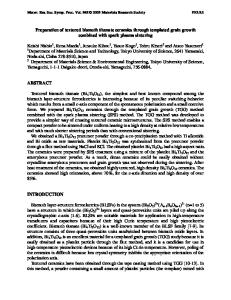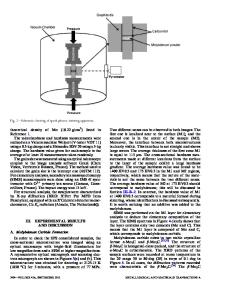Preparation of Ti-Al intermetallic compounds by spark plasma sintering
- PDF / 1,233,239 Bytes
- 5 Pages / 612 x 792 pts (letter) Page_size
- 92 Downloads / 465 Views
tudy was supported by ARO (Grant No. DAAH0495-1-0629) and NSF (Grant No. DMR-9987593). Useful discussions with C. Schuh (Northwestern University) are gratefully acknowledged.
Preparation of Ti-Al Intermetallic Compounds by Spark Plasma Sintering BINGCHU MEI and Y. MIYAMOTO Titanium aluminides based on Ti3Al(␣2) and TiAl(␥) stoichiometries have excellent potential to become some of the most important aerospace materials because of their high refractory nature, low densities, high specific strength, high melting temperature, and environmental resistance at elevated temperature.[1,2,3] There are three main phases (Ti3Al, TiAl, and TiAl3) in the Ti-Al binary system.[2] While various ␣2 alloys based on Ti3Al possess reasonable room-temperature ductility, their high-temperature applications are limited due to loss of strength, excessive oxidation, and susceptibility to hydrogen permeation. Increasing the aluminum content to produce ␥ - TiAl alloys can improve all of these properties but with the attendant penalty of reducing room-temperature ductility and toughness,[2] that is, the contents of ␣2-Ti3Al relative to ␥-TiAl are important as regards the properties of Ti-Al intermetallic compounds. Therefore, through microstructure control, some of their properties can be improved. The conventional melting or casting route of fabrication of titanium aluminides is unfavorable to improving their properties owing to segregation, resulting in many alternative techniques for producing these intermetallics being sought. One alternative method is spark plasma sintering (SPS), which is receiving increased attention.[4,5] The process diagram of this method is schematically shown in Figure 1. This method makes possible sintering and sinter bonding at a low temperature for a short period by charging the intervals
REFERENCES 1. T.G. Nieh, J. Wadsworth, and O.D. Sherby: Superplasticity in Metals and Ceramics, Cambridge University Press, United Kingdom, 1997. 2. D.C. Dunand and B. Derby: in Fundamentals of Metal Matrix Composites, S. Suresh, A. Mortensen, and A. Needleman, eds., ButterworthHeinemann, Boston, MA, 1993, pp. 191-214. 3. G.W. Greenwood and R.H. Johnson: Proc. R. Soc. London, 1965, vol. 283, pp. 403-22. 4. C.Y. Huang and G.S. Daehn: Acta Mater., 1996, vol. 44, pp. 103545. 5. A.C. Roberts and A.H. Cottrell: Phil. Mag., 1956, vol. 1, pp. 71117. 6. M. Frary, C. Schuh, and D.C. Dunand: Phil. Mag., 2001, vol. 81, pp. 197-212. 7. O.N. Senkov, J.J. Jonas, and F.H. Froes: JOM, 1996, vol. 48 (7), pp. 42-47. 8. P. Zwigl and D.C. Dunand: Metall. Mater. Trans. A, 1998, vol. 29, pp. 2571-82. 9. H.J. Frost and M.F. Ashby: Deformation-Mechanism Maps: the Plasticity and Creep of Metals and Ceramics, Pergamon Press, New York, NY, 1982. 10. D.C. Dunand and C.M. Bedell: Acta Metall. Mater., 1996, vol. 44, pp. 1063-76. 11. P. Zwigl and D.C. Dunand: Acta Mater., 1997, vol. 45, pp. 528594. 12. K. Kitazono, E. Sato, and K. Kuribayashi: Acta Metall. Mater., 1999, vol. 47, pp. 1653-60. 13. D.C. Dunand and P. Zwigl: U.S. Patent 6,042,661, 2000. 14. A.D.
Data Loading...











